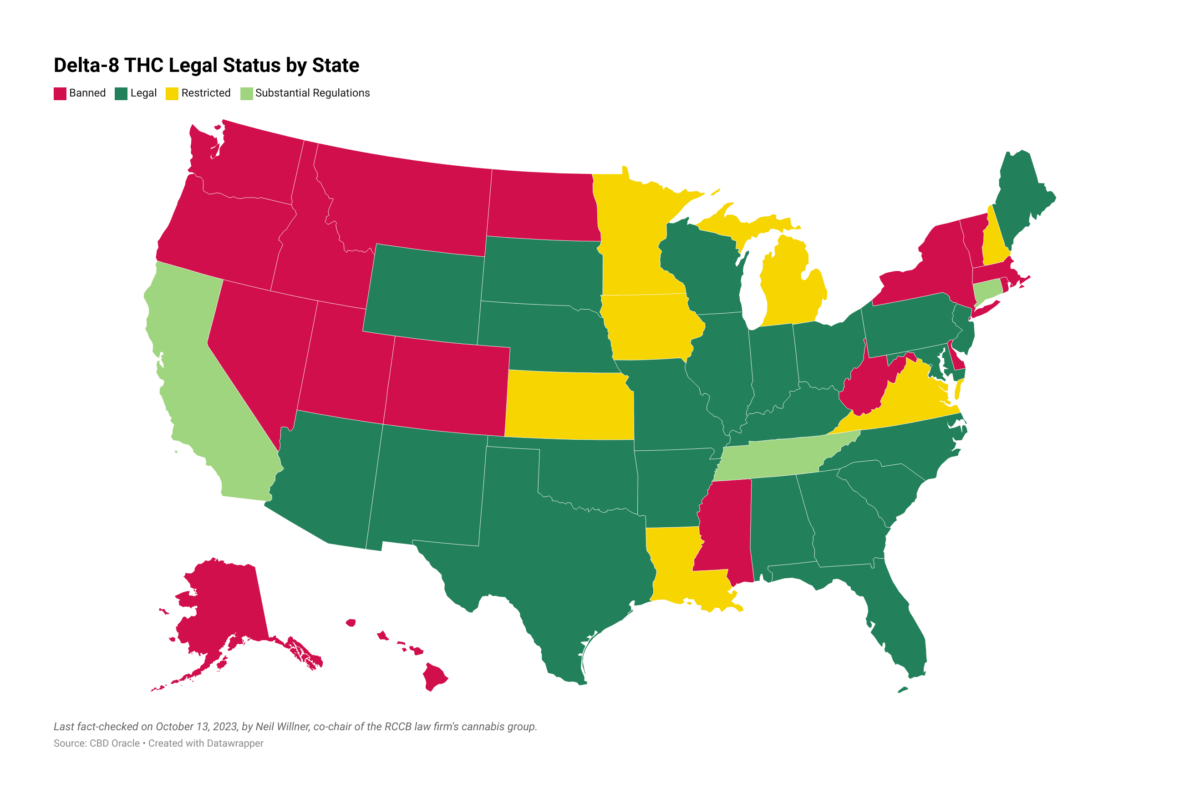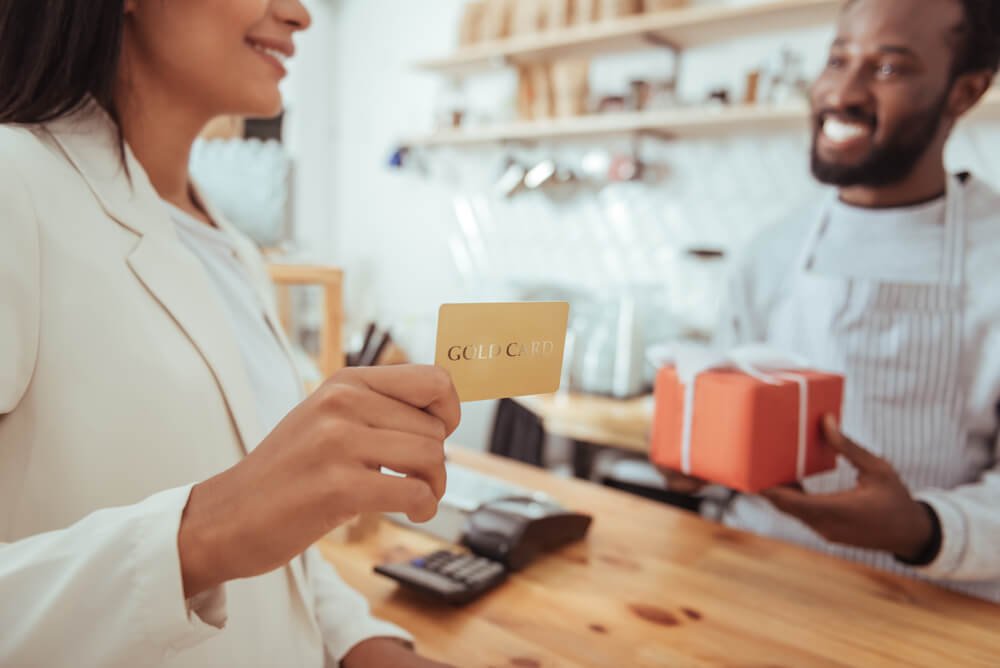Member Blog: Where Is Delta-8 THC Legal and Where Is It Banned? CBD Oracle’s Map Has the Answers

Delta-8 THC is probably the most controversial cannabinoid on the planet right now. With the 2018 Farm Bill being widely considered to have removed the THC isomer from the federal list of controlled substances, hemp and CBD companies quickly found a use for their excess CBD isolate. But if you’re considering selling delta-8 THC, federal law is only a part of the picture, and at state level, you have a patchwork of different laws and regulatory schemes to contend with.
This is why CBD Oracle, working alongside Neil Willner co-chair of the Cannabis Group at Royer Cooper Cohen Braunfeld, has produced a state-by-state map of delta-8 THC’s legality based on extensive reviews of state law. If you want to know what’s going on with delta-8 THC in a specific state, this is one of the best resources around to get the answer you’re looking for.
Delta-8 THC Is Legal in 22 States and 1 District With Limited Regulation
Despite the controversy surrounding delta-8 THC, it remains legal in 22 states and 1 district, with only limited regulation. This covers the following states:
- Alabama*
- Arizona
- Arkansas
- Florida*
- Georgia (?)
- Illinois
- Indiana (?)
- Kentucky*
- Maine
- Maryland* (?)
- Missouri
- Nebraska
- New Jersey
- New Mexico
- North Carolina
- Ohio
- Oklahoma
- Pennsylvania (?)
- South Carolina (?)
- Texas (?)
- Washington D.C.
- Wisconsin
- Wyoming*
Here, a * beside the state’s name means they’ve instituted age restrictions, preventing anybody aged 21 or under from buying delta-8 THC. States marked with (?) are currently involved in legal action about the status of delta-8 THC.
In the majority of these cases, state law basically follows the blueprint laid down by the 2018 Farm Bill with few or no additional rules. In fact, only a handful of states (Alabama, Florida, Kentucky, Maryland and Wyoming) have even passed laws preventing youth from buying delta-8 THC.
Legal actions are ongoing in several states, with the situation being slightly different in each. For instance, in Maryland, the hemp industry won a temporary injunction against the state, preventing the state from enforcing the provisions of House Bill (HB) 556 which relate to hemp until the action is resolved. The bill originally made it so that delta-8 THC products (and most CBD) could only be sold in licensed marijuana dispensaries, but this was deemed by the court to create a monopoly.
Delta-8 THC Is Banned in 17 States and Severely Restricted in 7 More
For every state where delta-8 THC is de facto legal, there is another state which has either banned or severely restricted the cannabinoid. In total, CBD Oracle’s analysis shows that delta-8 THC is banned in 17 states and severely restricted in 7 more. The states with bans are:
- Alaska
- Colorado
- Delaware
- Hawaii
- Idaho
- Massachusetts
- Mississippi
- Montana
- Nevada (technically could be approved for marijuana industry)
- New York (isomerization banned, could theoretically be sold in adult use)
- North Dakota
- Oregon
- Rhode Island
- Utah (possible in medical industry)
- Vermont
- Washington
- West Virginia
And there are severe restrictions – limiting all THCs to be under 0.3% for hemp products, unless otherwise noted – in the following seven states:
- Iowa
- Kansas
- Louisiana (all THCs must be under 8 mg per serving and 1% by dry weight)
- Michigan (all THCs under 0.3% and only marijuana-derived delta-8 allowed)
- Minnesota (all THCs under 0.3% and less than 5 mg per serving)
- New Hampshire
- Virginia (2 mg serving limit or >25:1 CBD:THC ratio)
Exactly how delta-8 THC is banned or restricted varies by state. For instance, while Colorado bans the “isomerization” process used to make delta-8 from CBD, Idaho basically bans anything that contains THC at all, even if it’s just CBD with trace, federally-acceptable levels of delta-9 THC. For the restricted states, most require that all THCs total to under 0.3% by dry weight, which is technically possible for a delta-8 THC product to meet, but essentially none do.
The analysis also revealed that – just like with marijuana – making delta-8 THC illegal doesn’t automatically remove it from a community. In Hawaii and Mississippi, for instance, despite state law banning delta-8 THC, it is still openly sold.
Only Three States Have Substantial Regulations on Delta-8 THC
In California, Connecticut and Tennessee, delta-8 THC is legal but has substantial regulations in place. In California and Connecticut, delta-8 THC is treated as marijuana and is sold as part of the adult use industry. This automatically institutes a wide range of requirements on the cannabinoid, including rules on testing and labeling to ensure safety and transparency for consumers.
Tennessee is the unique case here, where delta-8 THC is regulated as a “hemp-derived cannabinoid” and is legal to sell to adults aged 21 and over. Senate Bill (SB) 378 includes requirements for testing for contaminants, informative labeling and marketing which does not target youths, as well as a 25 mg serving size limit.
The Patchwork of Laws and the Future of Delta-8 THC
The key take-away for sellers of delta-8 THC is that current state regulations are a patchwork, making it very difficult to navigate for even the most responsible of companies. The product you can sell in Arizona without issues is probably not legal in Kansas, and would require batch testing and more to be sold in Tennessee.
This uncertainty may be resolved by the upcoming 2023 Farm Bill, but even this isn’t a sure thing. While the 2018 Farm Bill opened the door to a whole host of products and simply assumed (incorrectly) that the FDA would step up to regulate finished products, the new version might offer the clarity that was lacking. However, it’s just as likely that the bill will redefine “hemp” in a way that excludes delta-8 THC by default.
Pretty much the only thing you can depend on is that you’ll need to keep a close eye on state laws in the coming year. CBD Oracle’s map will be continuously revised to reflect the current legal reality and help responsible hemp companies remain compliant.
______________________________________________________________________________________
Lee Johnson is the senior editor at CBD Oracle, and has been covering science, vaping and cannabis for over a decade. He focuses on research-driven deep dives into topics ranging from medical uses for CBD to industry and user statistics, as well as general guides and explainers for consumers.
CBD Oracle is a cannabis consumer research company working to improve the safety and transparency of cannabis and hemp products, which publishes in-depth scientific, legal and consumer analyses on cannabis and cannabinoids.
Member Blog: Report Shows Inflation Will Reduce Dispensary Profits – Here’s What You Should Do

by Lee Johnson, CBD Oracle
A new survey from CBD Oracle found that if inflation drives cannabis prices up, most customers will start to buy less cannabis. Unfortunately, inflation isn’t going anywhere anytime soon, currently standing at 8.3%, and things are very competitive for both dispensaries and growers. Plus, the survey shows that the fear that customers will go to a competitor if you raise prices is actually very justified. So what can companies do? We’ve put together some suggestions that play on consumer psychology to help you stay profitable.
The Survey: Why It Looks Bad for the Industry
The survey from CBD Oracle asked 1,450 Americans in adult-use states about their buying habits and how they may change with inflation. While there were many results, the most interesting ones concerned how people would respond to more inflation and the price of cannabis increasing.
They found that 54% of respondents would buy less cannabis if prices increased as a result of inflation. Although over a third (37%) would buy around the same amount, it’s clear that there will be some impact on companies’ bottom lines. The survey also asked about the maximum amount people would be willing to pay for an eighth (around 3.5 g) and found that while 83% would pay $30, only 57% would still buy at $40.
But with increased prices for everyone from growers to dispensaries, it’s difficult to make ends meet at current prices. Mature markets like Colorado have an even bigger issue, with more than enough stock and tons of competition, so increasing prices may really feel like a gamble. The situation is totally unsustainable, and around 30% of dispensaries will be raising prices in the near future, if they haven’t already.
Andrew Livingston, Director of Economics & Research at Vicente Sederberg commented to us, “Cannabis is clearly not ‘inflation proof.’ Companies struggle to operate profitably as their cost of labor, distribution, and input ingredients climb along with prices across the rest of the economy.”
Raising Prices While Retaining Customers: A Guide for Dispensaries
The survey shows that the problem is on the horizon, but what’s the solution? Here are some suggestions.
Use Price Anchoring
Anchoring is a very useful psychological concept for dispensaries, and there are many ways you can benefit from it. The way it works is really simple. Imagine you have a “regular” price on the tag crossed out, and a sale price below it. Even if the sale price is still higher than customers might want to pay, customers note the crossed-out price and then look at the other relative to the original amount. So if your eighth is labeled “$35 $25,” customers “anchor” onto the $35 and the $25 seems like a bargain. This specific type is called strike-through price anchoring.
Anchoring Through Product Grouping
Price anchoring can be very powerful when used intelligently. For example, you could have your biggest-selling product on the shelf, but with a much more expensive strain beside it, ideally marked and labeled such that it’s hard to ignore. While very few customers will pay for that $50 eighth, that will make the $30 one sat beside it look much better.
Costco-Style Anchoring
In this approach, you arrange your store so that higher-price items greet customers – again, made hard to ignore through ads and positioning – and they anchor onto higher prices. Then as they make their way into the store and see your regular prices, they seem cheaper, even if they haven’t changed or have even increased.
Raise Prices Elsewhere to Keep Cannabis Cheap
You can also try to balance less profitable products out with other items. As McKinsey & Company suggests, raising prices on secondary and tertiary items (think grinders, bongs, vape pens, and other accessories) can help you recoup losses on key-value items (cannabis products). Combined with other approaches, this can be a clever way to boost profits while minimizing the risk customers will simply go elsewhere for weed.
Focus on Your Brand
With over half of dispensary customers sticking to the same seller, one way to minimize the impact of inflation is to make your brand their brand. Shopify’s report on the Future of Retail recommends focusing on your brand story (why are you in business? What sets you apart from the competition?), showing that your values align with customers’ and treating your employees as a “brand audience.” If you educate your employees about your brand, you will make them brand evangelists, improving customer loyalty as a knock-on effect.
Cut Costs Wherever Else You Can
Simply reducing costs on packaging – child-proof plastic packets rather than glass, for instance – can help you stay in profit without pushing costs to customers. Freezing hiring or even laying off staff is another alternative. This isn’t ideal, but if there are ways you can streamline, automate or digitalize processes, you may be able to cut back until the economy gets back on its feet.
Collect Data and Adapt
Arguably the most important thing you can do alongside any of these changes is to improve your data collection and response process. This is simply so you know the impact of the interventions as quickly as possible. You need to combine this with an enhanced decision-making process so you can make company-wide changes quickly and efficiently. It’s unlikely you’ll be able to make one set of changes and leave it that way, so set up systems to streamline the process for the future.
Conclusion: Remember, We’re All in This Together
With the report showing tough times are likely ahead for the cannabis industry, the most important thing to remember is that basically every dispensary in your state is in the same boat. If you’re friends with any other businesses in your area, talk to them about it and how they’re planning on responding. If prices must rise, it’s much better if you can present a united front to consumers. One dispensary raising prices might be a death sentence; all dispensaries raising prices is just inflation, plain and simple. Be up-front with each other and customers, and you’ll be surprised at how well you can pull through.
 Lee Johnson is a writer at CBD Oracle who has been covering science, vaping, and cannabis for over a decade. He focuses on research-driven deep dives into topics ranging from medical uses for CBD to industry and user statistics, as well as general guides and explainers for consumers. He is a passionate advocate of both CBD and cannabis, and a strong believer in informed choice for consumers.
Lee Johnson is a writer at CBD Oracle who has been covering science, vaping, and cannabis for over a decade. He focuses on research-driven deep dives into topics ranging from medical uses for CBD to industry and user statistics, as well as general guides and explainers for consumers. He is a passionate advocate of both CBD and cannabis, and a strong believer in informed choice for consumers.
CBD Oracle is a cannabis consumer research company working to improve the safety and transparency of cannabis products, producing in-depth research pieces, along with long-form analysis of social and legal issues.
Member Blog: How Cannabis Legalization In Minnesota Can Further Equality

By Mell Green, CBD Oracle
Medical cannabis hasn’t always had a smooth go in the United States. Thankfully, as time has slowly started to change and viewpoints have shifted, cannabis legalization is finally gaining traction state-wide. While this is an incredible feat for so many different reasons, many states see long-term benefits of cannabis legalization much further reaching than anyone could have imagined.
Today, we’re talking about how cannabis legalization in Minnesota may actually help further equality and break down barriers that have long been deeply rooted. Let’s get started.
FIRST GLANCE:
- Cannabis has a rocky history in the United States, with most negative stigma being racially charged.
- This ideology lasted for decades until some states started decriminalizing and legalizing medical cannabis in the 80s and 90s.
- Now, as cannabis legalization spreads, the divide between white Americans and POC in the industry is more prominent than ever.
- Legalization can help further equality in states like Minnesota, but it requires holistic change from within communities.
- With legalization may come fewer victimless crimes, resulting in lessened police presence, effectively leaving targeted communities feeling safer and more comfortable.
- By supporting local Black or minority-owned dispensaries and working with local organizations, cannabis equality may progress in the ways that community members need — but the change will start with you!
Cannabis’s Rocky History
Quickly, it’s essential to understand the tumultuous history behind marijuana and just how far we’ve come as a society. However, seeing this rocky past also helps illuminate how much further we still have to go.
The cannabis plant has existed for millennia on planet Earth. Its therapeutic benefits have supported civilizations in spiritual, religious, and medicinal ceremonies across the globe. As this idea spread to Western societies, the plant was, at first, welcomed with open arms. At the start of the 20th century, all of this changed entirely in the United States.
During the Mexican Revolution from 1910-1920, many Mexican citizens fled their war-torn home country in search of a safer, more promising future. With this, the U.S. saw an influx of Mexican immigrants.
Throughout Mexico, enjoying cannabis for its recreational effects wasn’t a new idea. So, when citizens began migrating North, they also brought more normalized recreational cannabis use. At first, for those in the U.S. who already adored cannabis, this was incredibly exciting. But, for many in positions of power, class, and wealth, this type of cannabis use wasn’t going to fly. Thus came the Reefer Madness film and decades-long racially charged cannabis persecutions.
The Impact of Legalization and Equality
It took way too long, but the United States finally started getting on board with cannabis decriminalization and legalization back in the 80s and 90s. With this, the exposure to cannabis science became more extensive, and it was easier to see that the plant did (and still does) have some serious medicinal benefit. Seeing these facts caused a lot of opinions to change, resulting in an almost domino-like effect of cannabis legalization across the country.
Now, 36 states have legalized medical cannabis, allowing more people than ever access to the precious plant they love. But has this legalization impacted the people most disproportionately punished? Not really.
Still today, we see Black men arrested for cannabis crimes at disproportionately high rates, even though cannabis is legal in most states across the U.S. If anything, these legal changes have made the divide all the more evident, allowing the country to see just how horrific the cannabis industry can be for people of color. At the same time, it simultaneously celebrates white American consumers. This may help boost PR for big business, but it doesn’t help local (black-owned or otherwise) businesses on the ground. Legally or economically.
So, what can we do to change this? How can cannabis legalization help to further the progress we’ve made?
Legalization in Minnesota: How To Further Equality
I know, it sounds like we’re a bit cynical, but it’s crucial to bring up these divides before discussing how we can move further. The country often loves to praise all the beauty that the cannabis industry brings, forgetting the intense harm it has caused so many communities.
Let’s talk about Minnesota, for example. In May, it looks as though the state is going to vote to pass adult-use cannabis use. If this happens, here’s what could potentially occur in terms of furthering equality — but, at the end of the day, this change is up to you.
Realistically, the legalization of cannabis should help reduce the number of victimless crimes in the area, helping the community feel more at ease. With this, you would also expect a lowered number of consistent police presence in areas where cannabis use was a previous “problem.” Often, when communities of color experience increased and frequent police presence, this does not provide a sense of safety. Typically, it provides the opposite. Thus, legalizing cannabis in places like Minnesota may be able to create an environment that not only feels safer but feels more accepting of all residents. Feeling safe is great for business, big and small – but especially small. Reduction of victimless crimes and less police presence could really boost the state economy, and additionally enhance everyone’s sense of community and unity.
Furthering equality through the legalization of cannabis can be done, but the work goes much deeper than just on a legal level. As we’ve seen, just because the law says one thing, that doesn’t mean it applies to all groups of people. So, once legalization happens in Minnesota — or your state — the next steps are in your hands.
What’s Still Left To Do
- Take the time to research Black and minority-owned dispensaries in your area and support these shops.
- See if you have any local cannabis equality organizations that specialize in helping those who have been wrongly affected.
- Educate others on the history of cannabis and why the subject can still be painful for POC.
With this, you’ll also understand how legalization is not an end-all-be-all solution. If we want to erase cannabis’s racially charged stigma, the answer is holistic: it starts with a community.
 Mell Green is a content creator who believes that cannabis can help anyone achieve a life-enhancing experience. Her participation in the advocacy of the plant for the last several years has not only allowed her to create solid relationships with the world’s leading cannabis companies, but it has also helped her to educate and spread awareness on the power of alternative medicine.
Mell Green is a content creator who believes that cannabis can help anyone achieve a life-enhancing experience. Her participation in the advocacy of the plant for the last several years has not only allowed her to create solid relationships with the world’s leading cannabis companies, but it has also helped her to educate and spread awareness on the power of alternative medicine.
CBD Oracle is a California-based online magazine dedicated to cannabis and CBD education. The company has made it its mission to provide specialized, expert advice to those who need it, publishing detailed, informative, and entertaining articles, guides, and reviews, all backed by the latest scientific studies and research.



 Lee Johnson
Lee Johnson
 Mell Green is a content creator who believes that cannabis can help anyone achieve a life-enhancing experience. Her participation in the advocacy of the plant for the last several years has not only allowed her to create solid relationships with the world’s leading cannabis companies, but it has also helped her to educate and spread awareness on the power of alternative medicine.
Mell Green is a content creator who believes that cannabis can help anyone achieve a life-enhancing experience. Her participation in the advocacy of the plant for the last several years has not only allowed her to create solid relationships with the world’s leading cannabis companies, but it has also helped her to educate and spread awareness on the power of alternative medicine.